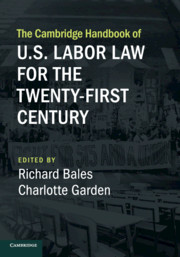Book contents
- Advance Praise for The Cambridge Handbook of U.S. Labor Law for the Twenty-First Century
- The Cambridge Handbook of U.S. Labor Law for the Twenty-First Century
- The Cambridge Handbook of U.S. Labor Law for the Twenty-First Century
- Copyright page
- Contents
- Contributors
- Preface
- Acknowledgments
- Part I Introduction
- Part II Labor Law Is Out of Date
- 3 Yesterday’s Labor Law and Today’s Challenges
- 4 The National Labor Relations Board in the Twenty-First Century
- 5 Beyond the Race to the Bottom
- 6 Union Rights for All
- 7 Public Sector Innovations
- 8 Combatting Union Monopoly Power
- 9 The Case for Repealing the Firm Exemption to Antitrust
- 10 Make Labor Organizing a Civil Right
- Part III The “Fissured” Workplace
- Part IV Barriers to Forming a Collective Bargaining Relationship
- Part V Barriers to Bargaining a Good Contract
- Part VI Unions, Civil Society, and Culture
3 - Yesterday’s Labor Law and Today’s Challenges
from Part II - Labor Law Is Out of Date
Published online by Cambridge University Press: 01 November 2019
- Advance Praise for The Cambridge Handbook of U.S. Labor Law for the Twenty-First Century
- The Cambridge Handbook of U.S. Labor Law for the Twenty-First Century
- The Cambridge Handbook of U.S. Labor Law for the Twenty-First Century
- Copyright page
- Contents
- Contributors
- Preface
- Acknowledgments
- Part I Introduction
- Part II Labor Law Is Out of Date
- 3 Yesterday’s Labor Law and Today’s Challenges
- 4 The National Labor Relations Board in the Twenty-First Century
- 5 Beyond the Race to the Bottom
- 6 Union Rights for All
- 7 Public Sector Innovations
- 8 Combatting Union Monopoly Power
- 9 The Case for Repealing the Firm Exemption to Antitrust
- 10 Make Labor Organizing a Civil Right
- Part III The “Fissured” Workplace
- Part IV Barriers to Forming a Collective Bargaining Relationship
- Part V Barriers to Bargaining a Good Contract
- Part VI Unions, Civil Society, and Culture
Summary
American labor law was constructed for one world; it is seriously dysfunctional in the very different world we now inhabit. The existing labor law framework was formed in an economy dominated by large, integrated, capital-intensive firms in manufacturing, communications, and transportation. Large branded companies like General Motors, General Electric, and General Foods employed their own production workers and janitors; those workers’ unions bargained with the power brokers of the national economy. Product market competition was bounded and muffled by a combination of trade barriers, regulation, and the sheer cost of transporting goods and services. Today, hypermobile capital, fissured production networks, deregulation, and globalized competition have utterly transformed the landscape of work. Those developments have weakened workers and empowered managers of the profitable “lead firms” that preside over geographically dispersed supply chains; they have separated most workers from the firms that profit from their work and govern their fate; and they have given firms greater means, motive, and opportunity to avoid or escape the constraints and costs associated with unionization.
- Type
- Chapter
- Information
- Publisher: Cambridge University PressPrint publication year: 2019
- 1
- Cited by

